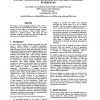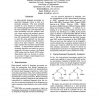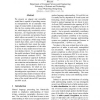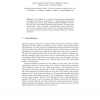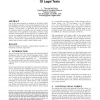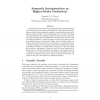LOGCOM
2008
14 years 21 days ago
2008
We describe a two-layer architecture for supporting semantic interpretation and domain reasoning in dialogue systems. Building systems that support both semantic interpretation an...
ACL
1989
14 years 1 months ago
1989
This paper shows that a first-order unificationbased semantic interpretation for various coordinate constructs is possible without an explicit use of lambda expressions if we slig...
ACL
1996
14 years 2 months ago
1996
We present a natural language interface system which is based entirely on trained statistical models. The system consists of three stages of processing: parsing, semantic interpre...
ACL
1997
14 years 2 months ago
1997
In data-oriented language processing, an annotated language corpus is used as a stochastic grammar. The most probable analysis of a new sentence is constructed by combining fragme...
ANLP
2000
14 years 2 months ago
2000
We introduce a framework for semantic interpretation in which dependency structures are mapped to conceptual representations based on a parsimonious set of interpretation schemata...
ACL
2006
14 years 2 months ago
2006
We present an elegant and extensible model that is capable of providing semantic interpretations for an unusually wide range of textual tables in documents. Unlike the few existin...
ESWS
2008
Springer
14 years 2 months ago
2008
Springer
PowerMagpie is a tool that brings semantic interpretation to classical web pages by dynamically--i.e. during browsing--selecting and making use of a wide range of online available ...
ICAIL
2007
ACM
14 years 4 months ago
2007
ACM
One of the main obstacles to progress in the field of artificial intelligence and law is the natural language barrier, but the technology of natural language processing has advanc...
JELIA
1990
Springer
14 years 4 months ago
1990
Springer
Traditional accounts of the semantic interpretation of quantified phrases and its interaction with reference and ellipsis have relied on formal manipulations of logical forms (qua...
AMTA
1998
Springer
14 years 5 months ago
1998
Springer
Abstract. We present an approach to semantic interpretation of syntactically parsed Japanese sentences that works largely parser-independent. The approach relies on a standardized ...

